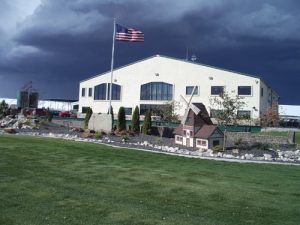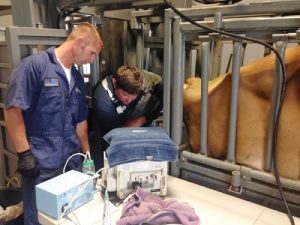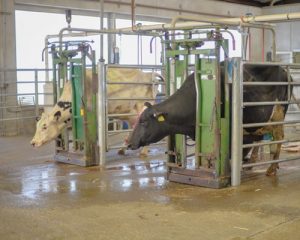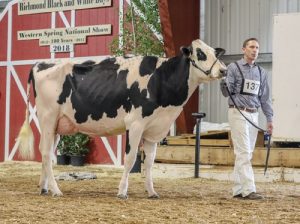The term passion can be defined as a strong enthusiasm or desire for something, or a strong and compelling emotion. Our industry has been blessed with people who are incredibly passionate about cows, and people who want to advance dairy genetics in a big way.
Nothing truer could be said of the team at Twin Ridge Genetics, a subsidiary of the Aardema Group, which is responsible for marketing and selling the elite genomic animals from Double A and Aardema Dairy.
Background

The Aardema Group is owned by brothers Don and Ron Aardema. Their father, Don Sr., milked 130 cows in California prior to relocating to Jerome, Idaho, in 1980.
Jerome was a good place to put down roots, because it had a good reputation for being “dairy friendly, with ample water, cheap feed and a hard-working labor force.” The Aardemas entrepreneurial spirit and focus on family and employees allowed them to grow their business considerably over the 25 years that followed.
In 2008, the Aardema Group, along with three other dairies, opened the largest dedicated high protein manufacturing plant in Jerome, taking in 3 million pounds of milk each day. This allowed the Aardemas to be vertically integrated from farming the land, to milking, to production, and the business model that worked very well.
In 2015, Twin Ridge Genetics was formed in a decision to focus solely on genetics and milk production, with thoughts of applying capital to what the Aardemas believed would be a higher return on investment long-term.
There are approximately 23,000 cows being milked by the Aardema Group currently: 13,000 cows, including 4500 Jerseys, are housed at Double A Dairy, the flagship of the operation. The rest are split between Aardema Dairy #2, #5, #6, #7 and St. Bridget Dairy. Two other subsidiaries within the Aardema Group are the Sawtooth Cattle Company, a calf and heifer raising facility which has 25,000 animals, and Harvest Pro, a custom farming operation that manages 8000 acres.
The Twin Ridge Team
The executive of Twin Ridge Genetics consists of Kurt McLaws (Chief Financial Officer of Double A Dairy), Jordan Leak (Chief Operating Officer), Joshua Wright (Herd Manager of Double A) and Ashley O’Hara (Genetics Manager).

While Curt oversees the financial end of the business, Jordan, Joshua and Ashley handle day-to-day dealings of Twin Ridge. The three of them met through cattle shows initially, and come from somewhat similar backgrounds that revolve around their respective family farms.
They all have one big thing in common: they’re passionate about genetics.
Jordan Leak has been with Double A Dairy for 13 years. Born and raised on a family farm in Idaho, Jordan managed a 2200 dairy right out of school, and discovered he loved working with people as well. He went to Jerome looking for a place to buy, but instead was sought out by the Aardemas with an offer to be the herd manager.
“One of my greatest passions is seeing everything reach its potential, and seeing people grow and develop,” says Jordan. “Being able to do that within an industry that I love on a scale like the Aardema Group was a win-win for me.”
The decision to advance their genetics provided the opportunity to create a position for Joshua Wright to manage the program and the growth. Josh was born and raised at Double Tree Dairy in Utah, which is still operated by his father Bill. As the herd manager for Double A Dairy for the past 4 ½ years, Josh is responsible for managing employees dedicated to reproduction, hoof- trimming, vet checks, the calving facility and fresh cows.
Ashley O’Hara has been with the company for a year and half, assuming the role of Genetics Manager. Originally from Dandyland Holsteins in Ontario, Ashley interned at Holstein Canada and Lewisdale in PEI, before spending two years at Butlerview where she then became in regular contact with the Aardemas.
“My perspective has grown so much here already,” she says. “When you surround yourself with positive, forward-thinking people, anything is possible!” Ashley’s main duties include genomic testing, bull sales, bi-monthly sales of bulls, and IVF program donor dams and matings.
Genetics Priorities

The mission statement at Twin Ridge is simple: to mass produce high genetically enhanced animals, and use genetics to improve the herd.
“Our goal is to become the premier supplier of genetics and the leader in cow care,” says Jordan. To achieve this goal, the early adoption of genomic science was necessary; now genetic testing at Double A has been the norm for the past 10 years.
Initially all heifers were tested as they were born, to get a feel of where they were sitting. “We really started seeing progress on the health of the animals in the data,” says Jordan. “The bell curve became bigger and bigger the more animals we tested. We realized that our bottom end was also quite high, and then the fun began!”
No bulls are used outside of the TPI and JPI lists when mating cows. “What we believe most in is sire stacks,” says Jordan. “We are consistently using good bulls that are the sires of sons.” A wide variety of sires are used in their breeding program, and are selected for traits like Net Merit, protein, Daughter Pregnancy Rate (DPR), health traits, Somatic Cell Score (SCS), sire calving ease and stature for the Holsteins.
“We generally use a ‘bull of the day’ breeding philosophy,” says Josh. “We use a certain amount of a bull and then move on, but we aren’t afraid to come back to a bull that seems to be doing really well in the program.” Individual matings are used for high donors that are in the IVF program, using very few bulls that aren’t pre-release semen.
Every female born at the dairy is genetic tested, along with every bull out of an embryo. Although every animal on the farm has basic ID, everything that is +2600 GTPI or higher is registered. Tools such as classification and milk recording are utilized along with registration to bring all the puzzle pieces together: “We all value the use of the genomic tools because it provides clarification for what we are doing,” says Ashley.
The intense focus on their own genetics has only happened in the past five years for Twin Ridge. After initially buying lots of animals and donors to further their goals, the herd is mainly ‘closed loop’ now, where every cow milked is a daughter of one of their own cows.

“We are always looking to diversify and expand our portfolio, and continue to seek out unique opportunities,” says Ashley. She also says the purchase of shares in Aristocrat, a Frazzle son who came in #3 on the NAAB list in April, is an example of investing in unique opportunities. “We are interested in cow families that have something unique like being polled, Red Carrier or A2A2. We’re not really sure how the A2A2 thing will play out in the US yet, but we’ll be ready with genetic options if it takes off.” Stud companies appreciate that the donor group at Twin Ridge is incredibly diverse and offers a wide range of options. “We have so many donors and can use that in a positive way to try new things.”
Sire Stacks First, Cow Families Second
At Twin Ridge, the use of top bulls with excellent sire stacks is paramount. The donor group is as diverse as it is, because they don’t place any limitations on where the bottom side pedigree comes from. “It doesn’t matter who she’s a daughter from, we work with whatever is high. You might have something pop up out of nowhere that you didn’t expect!” says Jordan. That said, some of the most popular donors in the Twin Ridge program can be traced back to families such as Lynmead Celcius Minnow, Ralma Juror Faith and Ronalee Outside Dabble.
Two cows very active in the Twin Ridge program are Triplecrown Delta 64 and Triplecrown Rubicon 990. Both are daughters S-S-I Platinum Mason 9024, who goes back to Celcius Minnow via Roylane Shot Mindy. Delta 64 has a daughter by Frazzled currently working the in the IVF program, who is +2805GTPI—her maternal sister by Viewpoint sold at the Westcoast Sale in March for $115,000. Rubicon 990 has two daughters by Detour that +2721 GTPI and +2653 GTPI respectively, they will have offspring of their own hitting the ground soon that could prove to be quite exciting.

A Bourbon daughter, Aardema Sweet Promise, has a GTPI of +2792 and her dam is Aardema Yode 19908, a Yoder daughter that goes back to No-Fla Massey 30194 who has several sons in AI. Early calves by TopNotch are starting to be born from Triplecrown-AL Mod 23699, a Modesty daughter out of Triplecrown-AL Monty 929 (Monterey) that goes back to the Dabbles.
On the Jersey side, 50-60% of bulls born in the Twin Ridge program go into stud. Three Vandrell daughters, JX Aardema 60654 {2}, JX Aardema 55200 {3} and JX Aardema 53833 {3}, have calves coming soon by Worldcup, Deluca, Usain Bolt, Stevens and Jodeci and all males are committed to Genex. Additionally, JX Aardema 56508 {2}, who is a Marlo x Decoy, has sons coming by Worldcup and Stevens that are committed to Genex, Alta and ABS.
“We have a lot of maternal lines on the Jersey side, all with very unique sire stacks that make them appealing to different studs,” says Ashley. To date there have been 150 Aardema-bred bulls in stud between the two breeds.
Established in the Marketplace
With over 100 embryos implanted weekly and 30,000 embryos implanted in the last 4 years, there are many opportunities for animal sales. “We usually sell around 400 head per month, both Holstein and Jersey,” says Josh. “They go all over the Western USA and Canada.”
The cows are generally sold in groups of 40-60, and are based on producer criteria. The animals are usually mid-tier for GTPI, and make excellent additions to other herds. “A unique thing about our program is that we don’t cut out the best and leave the rest,” says Josh.
Jordan adds, “one thing that has been incredibly satisfying for us is that we have been able to market our passion for genetics to others. Everyone that bought cows from us last year has come back for more, despite the low milk prices we’ve been able to continue to market out cows and its nice when buyers come back and say the ones they bought are outperforming their herdmates.”
Twin Ridge genetics can be found in Elite Sales such as the National Convention Sale, World Dairy Expo and the Derby Sale because “when large groups of diverse people are gathered, that’s the time to market,” says Jordan. In turn, Twin Ridge also purchases at these types of sales as well. Their marketing strategy is: don’t limit what we have and look for opportunities to have great relationships in the industry.
Passion for Cows, Passion for People
“Surrounding ourselves with smart people who are equally passionate about cows is what Twin Ridge is all about,” says Jordan. The group always aims to surround themselves with industry mentors and are not afraid to give and take advice. “We look for strategic partnerships to continue the progress constantly that is good for both parties.”

That mentality translates over to those working within the Aardema Group dairies. “We hire people that are particular and passionate about what they are doing. We want people to be happy in their jobs, take pride in their work and feel like they are a part of something bigger here,” says Josh. “Skills can be trained but character cannot.”
Feeling the same way about cows and genetics as they did when they were on their own family farms, Jordan, Josh and Ashley still believe they are part of a family farm at Twin Ridge. “We want to be good stewards with the cows we have, and we take a lot of pride in that,” says Jordan.
“Cow care is number one here, we want to see each cow realize her full potential and excel—not just the high genomic ones, all of them,” Josh adds.
With their combined love of genetics and the industry, and a culture of great people around them, we can expect to see Twin Ridge Genetics continue to advance their genetic profile in a big way, while pressing towards their goal of being the premier supplier of genetics.
Double A Dairy Cow Facts:
- Approx. 13,000 cows milked, shipping over 1 million lbs of milk/day
- Holsteins milked 3X/day, average 90 lbs/day (National Average: 75 lbs/day)
- Jerseys milked 2X/day, average 62 lbs/day
- 4 Double 50, rapid exit parallel parlours. Parlour 1 & 2 for main milking herd, Parlour 3 for hospital cows and Parlour 4 for Jerseys
- 4 employees milking at all times, 1 pushing up cows. No crowd gates, all-natural cow flow
- hooftrimmers are at Double A 6 days/week and trim about 175/day
Calving Facility
- Calving approx. 80 head/day at 2 sites (HO & JE)
- 3 employees at each calving facility 24/7, 5 employees during the day
- fresh cows receive chalk marks in different colors so that problems can be identified, rating on 1-5 scale determines the color
- easy/unassisted birth
- easy pull, right at the end
- harder pull
- had to go in and Get the calf
- surgery needed
- calving’s rated from 3-5 receive Exceed immediately
- fresh cows looked at daily, temperature taken on day 3, 5 & 7 (indicated by chalk marks on the hips) to be proactive and possibly prevent future problems
- cows go into general population at 17-20 days fresh
